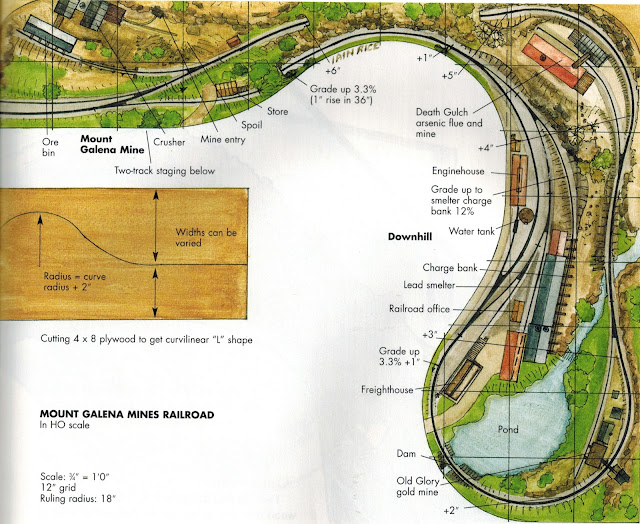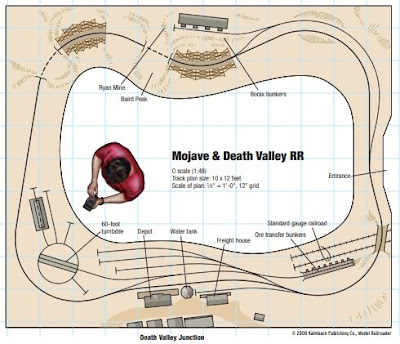The late Iain Rice was quite a talented track planner who brought a European design sensibility to layouts representing American railroads. His work is highly artistic and inspirational, though his layouts have sometimes been criticized as impractical to build or operate in the real world. Still, his track plans offer plenty of food for thought. This one is from his book, "Small, Smart, and Sensible Track Plans," published by Kalmbach:
This plan caught my eye because the overall configuration resembles the track plan in my previous post, and at 8 x 10 feet, it would easily fit my 10 x 15 foot maximum available space. I could actually enlarge it by 10 to 15 percent and still have room to expand off to the left.
It's a little unclear from the drawing, but the track at the top center (where it says "Iain Rice") doesn't connect to the one by the store; it's on a lower level and goes under the Mount Galena Mine area to a two-track staging yard. The track that runs behind the Death Gulch Mine continues to the Mount Galena Mine.
Rice is great at packing a lot of railroad activity into a small space. This plan has three mines, a smelter, a couple of other freight shipper/receivers, and an engine service facility, all in 32 square feet. If nothing else, the density of the plan, and Rice's signature no-straight-track style, give me some ideas for improving my own plans.
Minimum radius of this plan is 18 inches, which would accommodate most Bachmann locomotives and rolling stock, so I could live with that. I have enough space that I could enlarge the whole thing by 10 to 15 percent, which would increase the radius to 20 inches or a little more. I'd also need to adjust track spacing a bit for On30.
As it stands, I'd have to give up the idea of continuous running. In fact, with no runaround track at Mount Galena, this is really more of an oversize switching layout rather than a point-to-point -- which Rice discusses in the narrative accompanying the plan in the book. As designed, a Shay or other switcher would retrieve cars from the hidden staging tracks (interchange) and shunt a couple of cars at a time to the three different mines and other receivers.
If I built it, I'd probably use my five feet of additional space to extend the line past Mount Galena, create a passing siding and add a turntable, and as space permits, possibly one or two additional shipping/receiving businesses, perhaps a passenger station, and/or a bit of a town. In that case, I'd run pre-staged trains from the (enlarged) hidden staging tracks (Lockwood), through Downhill (Stauffer), and up to Mount Galena (San Emigdio), switching along the way. At Mount Galena/San Emigdio, the engine would be turned on the turntable, cars sorted, and then the train would return through Downhill/Stauffer to the staging yard. The train would be restaged manually before the next session. With five extra feet, I could have three or four good-length tracks in the staging yard and could run multiple trains before needing to restage them.
It would probably also be possible to add a reverse loop on the lower level and run point-to-loop, or maybe even connect the upper and lower level tracks for lap running.
Here's another plan from the Model Railroader track plan database that gave me a couple of ideas:
In real life, Colmanite from the Frazier District mines was hauled by wagon to Bakersfield or Victorville, transferred to railroad cars, then taken by train to a plant near San Francisco. So a narrow gauge to standard gauge ore transfer facility -- like the one in this plan -- would make sense for the L&SE. I could maybe replace the smelter at Downhill/Stauffer with ore transfer bunkers and have a standard gauge track run under the narrow gauge at the lower right, then up a canyon where the lake is on Rice's plan, ending on the discharge side of the ore bunkers -- similar to the Mojave & Death Valley track plan. Or I could put the ore bin on the other side of Downhill, widening the narrow section of benchwork near the middle of the layout, with a standard gauge track along the front edge.
Here's a reworked version of the Iain Rice plan, with track extended to the left as I discussed.
The loop at the right is 18 inch radius, same as the Iain Rice plan. This would work okay if I stick with smaller On30 equipment. I've shown the staging tracks in front of San Emigdio here; they could be on a narrow exposed shelf in this position or tucked away under San Emigdio. Both passing sidings are 4 or 4 1/2 feet long, enough for a locomotive and about five cars. There's room to stretch the San Emigdio siding to fit a another car or two if desired.
There's a nice stretch of open country at the upper right. I've indicated a canyon with bridges for both tracks, then heading right, the upper level track disappears into a tunnel for a few feet, leaving the focus on the front, lower-level track. The standard gauge track running under a trestle and up the canyon to the ore transfer bunker could be a dramatic scene if executed well.
Here's another version, but mirrored and rotated. This would take advantage of the existing benchwork from my old H.O. layout, with just the addition of a shelf on the right side.
This would be by far the easiest build, but somehow it's just not as appealing as some of the other options.
This next one is the same as the first version, but with a lower-level reverse loop instead of the stub-end staging tracks at Lockwood.
As drawn, there's a stub-end storage track inside the loop. The stub end track could be extended to become a smaller-radius reverse loop. I originally thought that if I did a reverse loop on the lower level, I'd widen the San Emigdio section to match. But I'm thinking now that I might leave it as it is, so the lower level staging tracks are more accessible for manually switching out equipment. On the other hand, if I widened the upper level, I'd have space for a Main Street scene.
In this next one, I've increased the radius of the reverse loop to 24 inches, taking advantage of the existing benchwork. I also widened the upper level benchwork above the loop by a few inches to give a little more room for scenery. In this version I have an exposed, stub-end track in front of the loop for easy staging of equipment coming on and off the layout.
I also increased the track radius at the Stauffer end to 21".
As I look at this, I realize it's taking up about the same space as the continuous running plans. In fact, it wouldn't take much to convert this to continuous running. Eliminate the switches at the throat of the reverse track, then shift the left side of the San Emigdio yard forward a few inches, so the main runs into the curve, on a downhill grade, does about a 210 degree turn, goes under the yard, and connects to the lower level track in front. Like this:
It's a little hard to unscramble the track on the left side, so here's another view with the hidden track pulled out, and some landforms added. I also shifted "Lockwood Switch" to the right a little, which slightly reduces the grade on track A-A; changed the 20/24 curved turnout at the left end of San Emigdio to a 24/28; and made a few other minor changes. There's a hidden staging/storage track under San Emigdio; I could easily add a second track.
As shown here, the grade going clockwise from San Emigdio to Lockwood Switch is about 3.2 percent, which is steep but probably acceptable with the short trains I expect to run.
This kind of gives me the best of both worlds. It could be run point-to-point, from the Lockwood staging track to San Emigdio, turn the locomotive on the turntable and run back. Or I could use the hidden cutoff for continuous running.
Scenically, it has the same features I like in the point-to-point or point-to-loop versions -- a decent stretch of mountain and canyon scenery in the supper right, and the canyon at the lower right, plus room for some town and industry buildings.
The benchwork at both ends is kind of wide -- a full four feet on the right side. But both ends are accessible, so most of the track, and all the switches, are within reach. The least accessible areas are mostly just mountain scenery.
Here's a crude 3D view:









Comments
Post a Comment